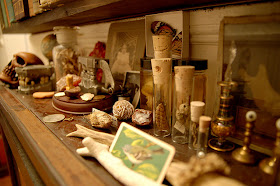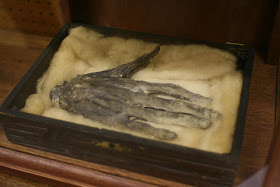
Photo from Curious Expeditions, found on Flickr, licensed under Creative Commons.
Some months ago, my book group read Bicycle Diaries, by David Byrne. The book didn't do much for me — but the part about the Wunderkammer caught my attention.
What's a Wunderkammer? Wikipedia says:
A cabinet of curiosities was an encyclopedic collection in Renaissance Europe of types of objects whose categorical boundaries were yet to be defined. They were also known by various names such as Cabinet of Wonder, and in German Kunstkammer or Wunderkammer ("wonder-room"). ...And here's what Byrne had to say:
The term cabinet originally described a room rather than a piece of furniture. The classic style of cabinet of curiosities emerged in the sixteenth century, although more rudimentary collections had existed earlier.
I reach the British Museum, where there is a show of curiosity cabinets. ...And I love that — even if I'm not convinced that Byrne is exactly right — because it illustrates an important organizing principle: There's no one right way to group your things. Organizers often encourage people to group "like with like" — but there are many different ways things can be alike. Just one example: Some people like to group their books by color, while that would drive other people crazy. We all need to just use whatever groupings work for us.
The objects in the Wunderkammer — preserved creatures, odd books and treatises, antique carvings, sacred objects from foreign lands — were often grouped, by Sir John Sloane and other collectors of that period, by whatever criteria seemed appropriate, be it shape, material, or color. There would be, for example, a mass of bulbous objects from various parts of the world and then some sharp, pointy ones grouped together. Many of these objects had nothing to do with one another except for having similar shapes.
Hardly what one would think of as a rigorous, enlightened scientific method of categorization. But thinking back on it, I would suggest that yes, in a truly enlightened world, all green objects are in a way related somehow, more than just by being green, and maybe they are related in a way we don't understand yet, just as all hexagonal objects might share a common trait as well. These crazy groupings might someday be seen as not completely arbitrary.
And any kind of taxonomy might be as good or valid as any other.
Another interesting perspective comes from David Pescovitz, who writes:
Several years ago, I became fascinated with cabinets of curiosity. The Renaissance predecessor to modern day museums, these cabinets, sometimes entire rooms, were filled with a mish-mash of objects, both natural and artificial, that embodied the wonder of the world. (The German term for these collections, wunderkammer, literally means "chamber of wonders.")
Inside, you might find a mummy's hand, a "unicorn's horn," exotic seashells from distant lands, odd insects pinned and cataloged, and possibly even a two-headed lizard in a jar of formaldehyde. As Tradescant the Elder, one of the most notable cabinet keepers in history, requested in a letter to the Secretary of the English Navy in 1625, this was a quest for "Any thing that is strang."


First photo by rojabo / Jim Brodie; second photo by twiggles / Chris. Both found on Flickr and licensed through Creative Commons.
Reading this reminded me of my visit to the Whitby Museum, where much of the museum serves as a sort of cabinet of curiosities. How else can you quite explain a museum that has a fossil collection as well as a hand of glory?
But Pescovitz went on to say:
Many blogs, including the one I co-edit, have been described as virtual cabinets of curiosity — storehouses of unusual links, odd memes, fringe culture, and weird news.So welcome to my very own cabinet of curiosities, which I've been creating for exactly five years now!
Hi Jeri, this is a great one! I learned about Cabinets of Curiosities as an art student and have been in love with the idea ever since! As I do tend to collects bits & bobs myself I created a display for them in my hallway using a long narrow hanging cabinet from IKEA (meant to hold CDs and/or DVDs). It creates a focal point in a small space and fits our modern sensibility. The only problem is that its almost full! (and IKEA has discontinued these cabinets). Cheers!
ReplyDelete